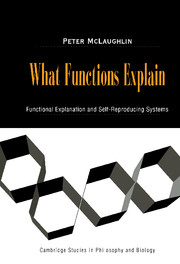1 - Introduction
Published online by Cambridge University Press: 12 August 2009
Summary
We give and take functional explanations – not any old functional explanation and not of anything and everything. But there are occasions when we accept reference to the function of something as a satisfactory answer to a genuine why, how, or what question. And we often do this without – at least knowingly – presupposing or implying that there is any intentional agency involved. Under the appropriate circumstances certain kinds of things are explained, to the satisfaction of those involved, by appealing to their functions. In many areas of the life sciences, such references may in fact merely be shorthand for hypotheses about the past or present adaptive value of organic or behavioral traits and about the role of natural selection in their genesis; but this is certainly not always the case. And biology is not the only discipline in which functions are regularly adduced. Functional explanation has also been rampant in the social sciences.
There is a large philosophical literature on functional explanations. The statement ascribing a particular function to some entity can be interpreted as the answer to a number of different questions. We might ask:What does the heart do? What role does it play in the operations of the body? Which organ pumps the blood? Why do we have a heart? Which organ is it that has the function of pumping the blood? What is the function of the heart? Why does the blood circulate? To these and many other questions we might in the appropriate context sensibly reply: “The function of the heart is to pump the blood.”
- Type
- Chapter
- Information
- What Functions ExplainFunctional Explanation and Self-Reproducing Systems, pp. 3 - 15Publisher: Cambridge University PressPrint publication year: 2000



